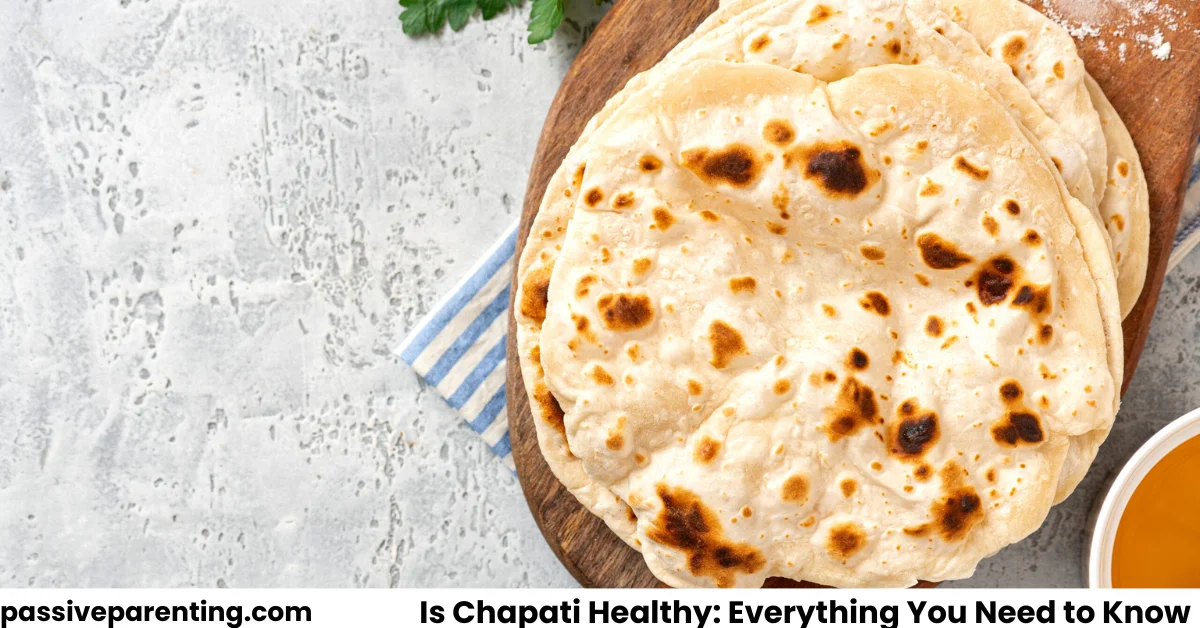Chapati is one of the most common foods in Indian households and a daily staple for millions of people worldwide. But as health awareness grows, many wonder, is chapati healthy? Understanding its nutritional value, benefits, and how it fits into your diet can help you make informed choices about what you eat every day.
This article takes a deep look into chapati’s nutrition, health effects, and practical tips to make it even healthier while keeping it delicious and satisfying.
What Is Chapati
Chapati, also known as roti, is an unleavened flatbread made from whole wheat flour (atta) and water. It is cooked on a hot griddle or tawa until it puffs up and turns golden brown.
The simplicity of chapati makes it unique; no yeast, oil, or additives are needed, which is one reason many consider it a healthy carb source. It’s light, easy to digest, and pairs well with vegetables, pulses, or proteins.
Chapati vs Roti vs Paratha
Although the words chapati and roti are often used interchangeably, chapati is typically softer and smaller. Parathas, on the other hand, are layered and cooked with oil or ghee, which makes them richer in calories and fat.
When eaten plain or with minimal fat, chapati remains one of the most wholesome options among Indian breads.
Nutritional Value of Chapati
Understanding the nutrients in chapati is essential to know whether it truly qualifies as a healthy food.
Basic Nutritional Breakdown (Per One Medium Chapati)
- Calories: 70–100 kcal
- Carbohydrates: 15–18 g
- Protein: 3–4 g
- Fat: 1–2 g (depending on whether oil or ghee is used)
- Fiber: 2–3 g
- Calcium, Iron, Magnesium, B vitamins: Present in small but beneficial amounts
Chapati provides complex carbohydrates, meaning the body digests them slowly, releasing energy steadily instead of spiking blood sugar.
Health Benefits of Chapati
Now that we’ve seen its nutritional makeup, let’s explore the health benefits of eating chapati regularly.
1. Supports Digestion
Chapati made from whole wheat flour is rich in dietary fiber, which promotes healthy digestion and prevents constipation. It helps maintain gut health and regular bowel movement.
2. Helps in Weight Management
For those aiming to maintain or lose weight, chapati is a smart choice. The fiber keeps you full for longer, reducing cravings and unnecessary snacking.
3. Good Source of Energy
Chapati provides steady energy through its complex carbohydrates. Unlike refined carbs, it doesn’t cause quick sugar spikes and crashes, making it ideal for sustained energy throughout the day.
4. Heart-Healthy Choice
Whole wheat contains magnesium, potassium, and fiber that support heart health by improving cholesterol levels and promoting better blood circulation.
5. Aids Blood Sugar Control
Because of its low glycemic index, chapati can help control blood sugar when eaten in moderation. It is often preferred over rice for people managing diabetes.
6. Boosts Nutrient Intake
Chapati offers essential nutrients like iron and B vitamins that support metabolism and energy production. When paired with vegetables or pulses, it becomes a balanced meal.
Is Chapati Healthy for Everyone
While chapati is nutritious, individual health needs vary. It’s important to understand how it fits into specific dietary requirements.
Chapati for Weight Loss
Yes, chapati is suitable for weight loss when portion-controlled. Avoid adding ghee or butter in excess and pair it with high-protein and fiber-rich sides such as lentils, tofu, or vegetables.
Chapati for Diabetics
For people with diabetes, chapati can be healthier than white rice because it releases glucose slowly. However, eating too many at once can still raise blood sugar levels. Balance and moderation are key.
Chapati for Gluten-Sensitive Individuals
Since chapati is made from wheat, it contains gluten. Those with celiac disease or gluten intolerance should avoid it and try alternatives made from millet, jowar, or bajra flour.
Chapati in High-Protein Diets
Chapati alone is not high in protein but can easily be balanced with dals, paneer, or grilled meat to increase total protein intake.
Comparing Chapati with Other Foods
Chapati vs Rice
Chapati contains more fiber and protein compared to white rice, which makes it more filling and better for blood sugar control. However, rice is lighter and easier to digest, which may be preferable for some.
Chapati vs Bread
Commercial white bread often contains preservatives, sugar, and refined flour. Chapati made from whole wheat flour is a healthier, cleaner choice with fewer additives.
Multigrain Chapati vs Wheat Chapati
Multigrain chapatis are made with a mix of flours like wheat, jowar, bajra, and oats, offering more nutrients and fiber. However, whole wheat chapati remains a strong everyday option for balanced nutrition.
How to Make Chapati Healthier
You can make your chapati even more nutritious with simple modifications.
Use Whole Grain or Multigrain Flour
Using unrefined flour ensures you get maximum fiber and micronutrients. Multigrain flours enhance the nutritional value even more.
Add Seeds and Herbs
Incorporate chia seeds, flaxseeds, or methi leaves to boost fiber, omega-3s, and flavor.
Control Oil or Ghee Use
While a touch of ghee adds taste and healthy fats, excessive use can increase calorie intake. Keep portions moderate.
Pair Wisely
Eat chapati with balanced sides, vegetables, lentils, lean protein, and yogurt for a wholesome meal that delivers sustained energy.
Common Myths About Chapati
Myth 1: Chapati Causes Weight Gain
When eaten in moderation and without excessive fat, chapati supports weight management. Overeating any carb source can cause weight gain, not chapati alone.
Myth 2: Rice Is Always Less Healthy Than Chapati
Both rice and chapati have benefits. The right choice depends on portion size, activity level, and digestive preferences.
Myth 3: Eating Chapati at Night Is Bad
Chapati can be eaten at night if portion sizes are controlled and paired with light vegetables or soups. It digests slower than rice but keeps you full longer.
Portion Control and Balanced Diet
How much chapati you eat depends on your calorie requirements, activity level, and overall diet.
How Many Chapatis per Meal
- For weight loss: 1 to 2 medium chapatis per meal.
- For maintenance: 2 to 3 chapatis per meal, depending on energy needs.
- For athletes or high-activity individuals: 3 to 4 chapatis per meal, combined with protein and fiber.
Smart Pairings
Balance your chapati with a mix of vegetables, protein, and healthy fats. For instance, a meal of chapati, lentils, and salad creates a satisfying nutrient-dense plate.
Tips for Healthy Eating with Chapati
- Use freshly ground whole wheat flour for better nutrition.
- Avoid storing dough overnight, as it may lose some nutritional quality.
- Cook on medium heat to retain softness and nutrients.
- Drink enough water, as fiber-rich foods need proper hydration to aid digestion.
- Rotate flours occasionally by mixing in oats, bajra, or ragi to diversify nutrients.
Frequently Asked Questions
Final Thoughts
So, is chapati healthy? Yes, when made with whole wheat and eaten in the right quantity, chapati is a wholesome, energy-boosting, and fiber-rich food. It’s an excellent source of complex carbohydrates that fuel your body and support digestion.
The key is balance. Combine chapati with vegetables, proteins, and good fats to create a diet that nourishes and energizes. Whether your goal is weight management, better digestion, or simply a balanced lifestyle, chapati remains one of the most dependable and nutritious foods you can include in your daily meals.




